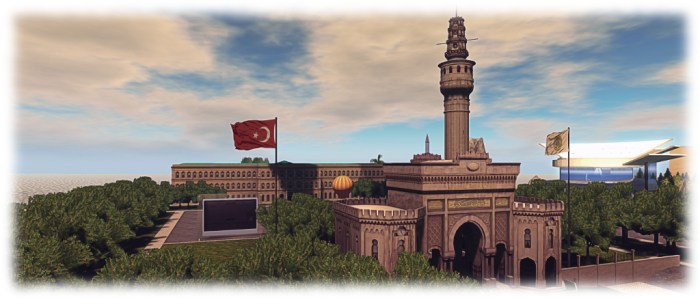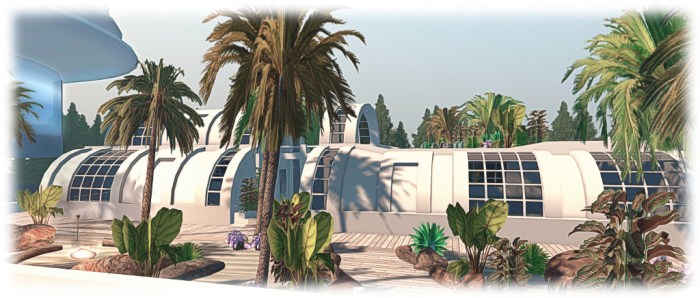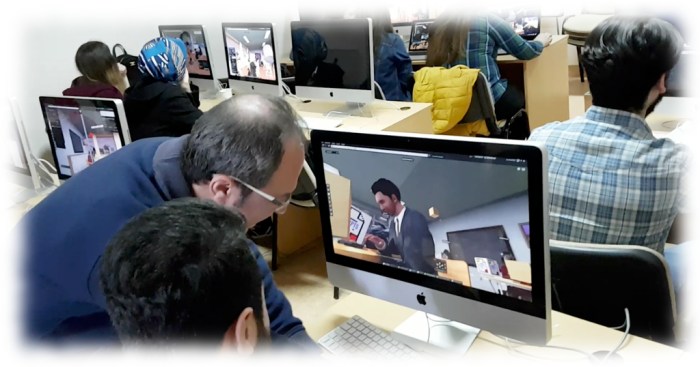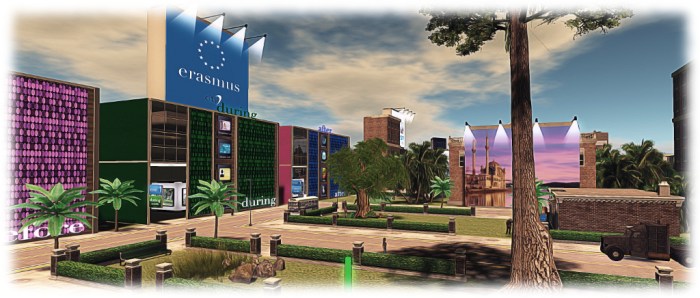
*With apologies to Jimmy Kennedy.
The Drax Files #44 arrived on Monday, April 10th. It is a somewhat timely piece in content, returning as it does to the subject of Second Life and its role as an educational tool (first examined far back in segment #19) which has arrived shortly after the 10th Virtual Worlds Best Practice in Education Conference has closed its doors in Second Life.
This segment is slightly longer than recent instalments of World Makers, running to one second under 6 minutes. The focus is very much on the work of Professors Tuncer Can and Irfan Simsek from Istanbul University, but the episode encompasses far more than examining looking at how the professors and the university use Second Life to enable and empower student learning.

“I’m really trying to summarise what are the defining factors that make Second Life work for education,” Drax told me as we discussed the segment.
“I’ve striven to have some detail [through the examination of Istanbul University’s presence in SL] but moreover I’ve striven to give a feeling of the freedom Second Life brings to education. Not just for the teachers, but for students as well. The emphasis is on the fact that Second Life can create an atmosphere of freedom that unleashes energy in the students, encouraging them to participate in the learning process.”
A core part of this freedom is the fact that Second Life presents students full agency over how they represent themselves in-world and the security that they have control over how much they reveal about themselves – and how much (if anything) can be traced back to them. This aspect of identity / anonymity is something oft touched upon in many areas of Second Life, but it is perhaps not so well recognised when it comes to education, where one would perhaps expect things to be more regimented.

“They want to reflect their own real character that lies behind their social masks,” Tuncer Can notes in the video. “I had one student whose voice I had never heard in my life; and instantly, when we had this virtual education class, he started using all of his experiences! He said that the anonymity that Second Life allows, nobody looks at me, and I started sharing.”
Tuncer sees this as a vital part of encouraging learning and giving student a greater freedom, as Second Life encourages students to remove the affective filter, causing them to be more receptive to learning, their peers and their class leader.
“That’s why I dwell on these different avatars,” Drax continues. “I have the feeling this is not really a priority right now in many of the VR applications. The ability to openly define yourself, which has a kind of creative chaos which can be leveraged by a skilled educator to open out the learning process. That’s what I’m really trying to show.”

Second Life can help remove the affective filter in other ways as well. For example: many – if not all – students today are at least semi computer literate. They have games, the Internet, social media, and so on. Thus, they have a natural curiosity when introduced to Second Life, a desire to find out what it is, what they can do within it. This naturally pushes their affective filtering to one side, generating a desire to learn.
“You see this in the shot of students playing with the prims. I have so much footage where you see prims floating all over the classroom” Drax says (starting at around the 1:25 mark). “We gave the students scripts and let them play with the prims, and we filmed everything in real-time in Second Life and in the classroom at the same time. It was not a structured lesson; we weren’t teaching them scripting or coding. They weren’t doing that per se, but they were learning as they played.”
Istanbul University is the perfect focal point for a broader examination of immersive environments in education for a number of factors. It has around 200,000 students, many of whom come from far afield, marking it a melting point of cultures and social influences, any of which might influence the depth of affective filtering any particular student might already naturally feel.

Through Tuncer Can and Irfan Simsek, the University has been involved in using Second Life as an educational tool for a decade. This give the professors an in-depth perspective on how immersive tools might be used, and – through their technical abilities – a keen understanding of what the future of VR might bring and what are, for the time being at least, the limitations of the new wave of VR systems.
Some of this is touched upon in the video. Again as an example, take Erasmus City, as visited in the segment. It’s a unique environment, allowing students who are about to study at the university to visit it in virtual form, and gain a broader understanding of what their time at the university – and after – will be like. It’s a fascinating take on student orientation which not only helps students better understand the university and manage their expectations, but also offers a unique opportunity for social interaction between students before they even arrive in Istanbul.
Technology-wise, the focus right now is on the new era of VR as personified by the broad range of VR systems from the high-end HTC Vive through to elements such as Cardboard and Daydream. But, as Tuncer touches upon in the video, this entire new ecosystem is actually a big unknown, and raises more questions than it answers. This is not just an issue of cost of high fidelity headsets – specifically mentioned towards the end of the piece – it is the whole ethos of approach.

“VR is at a point of transition,” Drax elaborates in our conversation. “We don’t know where it is headed. It’s fascinating, but there is nothing out there that really works. That’s something a lot of educators are questioning; there really isn’t a platform like Second Life. High Fidelity is way too complicated, and Sansar is not open yet.
“So this is where we’re stuck right now. Of course there’s Google Expeditions, and things like that, but right now only Second Life is out there and is known to work. And the price point, raised by Tuncer, is a legitimate point. People will of course say, ‘Well, you can always get Google Cardboard and let students us their own devices’. But students using their own devices is an issue for some schools. So, where VR is concerned, there’s a whole set of issues which no-one is really addressing.”
Second Life, however has addressed many of the questions. Its success as an educational tool lies within its track record of use across a range of teaching disciplines. It is not something that is going to go away as use of consumer-based VR grows in use. But it is something which will remain relevant for some time to come and – for the wise at least – inform them as to how VR should be considered in the educational realm.
Once again, Drax has delivered another outstanding segment for World Makers, one which in itself see a return to the seeds of the show, in that like the first in the series, it is led by Drax himself – although this time purely in the form of a narrative voice over. It’s the perfect way to round-out the circle for the series.
Reblogged this on KULTIVATE MAGAZINE.
LikeLike
I just finished teaching a beginning tarot course (5 weeks) inside SL. I created the tools necessary for teaching it (I hired someone for the scripting parts).
LikeLike